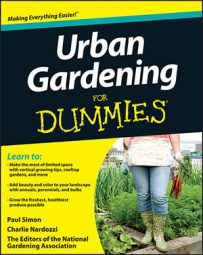Digging a hole big enough to add a tree or shrub to your garden in urban soils can be challenging. Many urban soils are compacted or made up of gravel, fill, and concrete. Often what looks like a nice green lawn is really only a few inches of topsoil on top of old construction debris and fill.
After you have the hole, the planting process is similar to the way you plant many other plants. Here’s a quick look at how to plant a tree or shrub, from digging the hole to laying the mulch:
Dig a hole.
Regardless of what kind of soil you have, follow these tips to dig a good hole:
Dig it wide. Dig the hole three times as wide as the root ball. For bare root plants, just dig the hole wider than the extent of the roots when you spread them out horizontally.
Most tree and shrub roots grow in the top foot of the soil, so they need room to expand as the tree grows. By loosening the soil around the root ball, you give those young roots a place to take hold. If the soil is rock hard, the roots won’t penetrate it and they’ll just stay around the root ball.
Don’t dig too deep. Dig the hole just deep enough so that the top of the root ball is level with the native soil. When you set the root ball on undisturbed soil, it’s less likely to settle later and end up planted too deep.
Place the plant in the hole.
For container plants, remove the pot. If you can’t get the root ball out of the container, run a sharp knife around the inside edge of the pot and cut off any roots that protrude from the drainage holes. You may have to tease out the root ball if it’s heavily root bound.
For balled and burlapped plants, rock the root ball to one side and then the other to remove any burlap, twine, and wire. Just be sure to push on the root ball, not the trunk, or you may break off roots inside the ball.
Although it’s biodegradable, the burlap may take years to break down and it’s best to remove as much non-plant material as possible without causing the root ball to fall apart. If you notice any roots that are kinked or encircling the root ball, trim them away.
For bare root plants, make a small, volcano-like mound in the center of the planting hole and drape the roots evenly over the mound.
Check the height of your plant.
Stand back and take a look at your work. Rotate the tree or shrub so that it looks the way you like. Double-check the height of the plant in the hole to make sure it’s not too shallow or too deep.
Backfill the hole to the soil line.
In most cases, you should backfill your hole with the native soil that you dug out. The tree or shrub needs to get used to growing in the native soil, so it’s best to use it from the beginning. However, because many urban soils lack fertility and even real soil, sometimes you have to amend your native soil with a combination of compost and topsoil.
Don’t make the soil in the hole too fertile. If the soil around the roots is too different from the native soil, the roots will stay only in the planting hole and not venture out into the native soil. As the roots grow in the confines of the planting hole, they can encircle the trunk and eventually strangle the tree.
Also, during a strong wind storm, a large urban tree may blow down if the roots haven’t anchored themselves well into the native soil.
As you backfill the planting hole with soil, run a hose on a trickle or add water from a watering can in the hole at the same time. The water helps remove any air pockets from the soil, making for less settling later, and keeps the roots moist.
Make a basin.
Make a low berm of soil around the outer circumference of the planting hole to create a basin that will catch water and direct it to where the new roots are. When you water, just fill up this basin and let the water naturally drain into the soil.
Add a 2- to 4-inch-thick layer of bark mulch over the root zone.
The mulch helps preserve the soil moisture and keeps weeds from growing and competing with your tree. Keep the mulch a few inches away from the trunk of the tree or shrub. Mulch that sits right next to the trunk can cause disease problems, especially during wet weather.
Unless you live in a windy area or you plant a large tree, you probably don’t need to stake your trees and shrubs. But if you want to add stakes, here’s how:
Place two stakes opposite each other and perpendicular to the prevailing winds.
Use commercial tree ties or soft cloth to wrap around the stakes and tree at a height just above a side branch or about halfway up the trunk.
Don’t tie the tree tightly. You want to allow your tree to rock in the breeze; the natural movement of the trunk in the wind builds trunk and root strength.
Remove the stakes after one year when your tree is well enough established to stand on its own.

